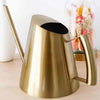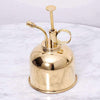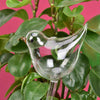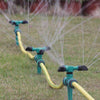
How to Water a Poinsettia Properly
of reading
Intro: Some information about this tropical plant
Full name: Euphorbia Pulcherrima .
Where does the Poinsettia come from?
Native to Mexico , the Poinsettia is a shrub from tropical forests . Its local nickname "Flores de Noche Buena" means Christmas flower . It is easily recognizable by the bright red of its large, petal-like leaves , called bracts . This bright color allows it to attract the attention of pollinators . Once attracted by the leaves, the bees discover a flower in the shape of small yellow buds . This green (and red) plant is internationally popular, to the point of being celebrated every year in many countries on December 12 (France, Spain, USA, etc.)!
Although native to a warm, tropical climate, this plant is associated with Christmas. It's sold at this time of year, and its color pairs particularly well with Christmas decorations. However, nothing is stopping you from keeping it and growing it beyond that. It will bring color and life to your interior decor ! To make a Poinsettia last, you'll need to know its secrets, including how to water it...

How much water does he need?
When it comes to watering, the Poinsettia suffers from both a lack and an excess of water . It is important to check the moisture content of the soil before hydrating it. Then, stick your finger in a few centimeters deep. If the soil is dry, it is time to water.
To confirm your opinion, you can also lift the pot . If it feels light, it means that the water has been absorbed or has evaporated. The soil should ideally be moist but not soggy or flooded . On the other hand, if the soil has completely dried out, we recommend watering the plant thoroughly .
The impact of your environment on watering.
The frequency of your watering will depend on factors both inside and outside your home. A plant placed next to a heat source like a radiator will dry out when exposed to hot air. Your room's exposure to sunlight will also have an impact.
External elements are the climate of your geographical location , as well as the season for example.
Plants are sensitive organisms that adapt their development to their living conditions.

How to Water a Poinsettia?
The first thing to do when purchasing your Poinsettia is to check if its flower pot has drainage holes . If the pot doesn't have one, drill one with a nail or screwdriver.
Neglecting this step would cause water to stagnate in the root system . You would then risk seeing its roots rot until your plant dies.
If your florist has decorated your pot with decorative paper , it is best to remove or pierce it as well . This may prevent water from draining .
To water it, we recommend using an indoor watering can . These allow you to dose the watering correctly . Their aesthetic appearance and affordable price make them an essential item for combining interior design and gardening !
If you don't have a watering can, whatever you have at hand will do. Place your plant over the sink and water it. Remember, the goal is to hydrate the soil and the roots of your plant .
Vaporization:
To refresh your entire plant , we recommend spraying it. Its beautiful red leaves (bracts) will then retain their life and shine. The frequency of spraying will, of course, vary depending on the temperature and humidity of your room .
Fill your spray bottle with room temperature water and spray the plant's foliage this time.
Signs of poor watering:
If your plant starts to weaken with leaves that appear to be wilting , there is likely a watering problem . The finger test in the soil allows you to easily identify whether it is an overwatering or underwatering problem . Unfortunately, many hobbyists make the mistake of watering even more an overwatered plant that is wilting . Keep in mind that overwatering is the number one cause of death for houseplants.

How do I grow my Poinsettia indoors?
To get the most beautiful Poinsettias, you need to keep in mind the tropical nature of this plant.
Poinsettias thrive at room temperatures between 16 and 22°C . Cold temperatures can stress them, slow their growth , or kill them . As with many other plants, we recommend keeping them away from radiators and windows.
Regarding its exposure to light, maximum brightness is desired .
Also, be careful not to leave this plant within reach of your pets , for whom the sap is harmful . The milk ducts of the plant also contain a white latex similar to rubber, which can bother people with latex allergies .
The seasonality of the Poinsettia:
- Around March 1st => You can fertilize it using a water-soluble liquid fertilizer . This plant responds particularly well to regular fertilizer applications.
- End of March / Beginning of April => Pruning & fertilization .
- May 1st => Place your plant outside when the risk of frost has passed. The location should be shaded and protected from strong winds. You should then continue to fertilize and water regularly.
- 3 to 5 weeks later => Place your plant in the sun . You can take the opportunity to repot it.
- August => Second pruning possible, if the plant has grown too much.
- October & November => Formation of red bracts . Place your plant in a sunny room and fertilize one last time before March. The Poinsettia is photoperiodic . It needs darkness throughout the night during the fall to trigger its flowering. You can cover the plant with a box from 5 p.m. to 7 a.m.
- Christmas => Flowering .
Welcome to the Watering Can Shop!
Learn more about your plants and equip them to help them grow and thrive! :)









Anureva43
Très bon article ..merci